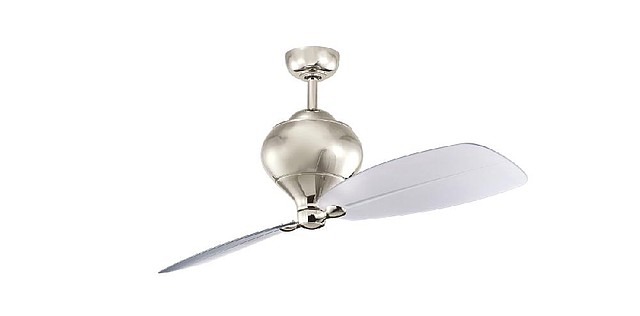Furniture styles put spin on fan designs
The Arius by Kichler Lighting follows the trend toward lighter fan finishes, including polished nickel and chrome.
Saturday, June 2, 2012
LITTLE ROCK — Buying a ceiling fan isn’t just about nuts and bolts, motors and blades. Ceiling fans are about design and style. Shoppers no longer encounter fan after fan with curvaceous, wooden blades and fluted light fixtures. Instead, fans have become more linear, shinier and, in some cases, completely unadorned.
“The industry as a whole is pulling out of the highly decorative, Tuscan designs that were extremely popular in the early 2000s and into minimalistic, streamlined designs,” says Bethany Pirtle of Emerson Comfort Air Products. Traditional designs still account for a good portion of the market, but contemporary designs are gaining on them, Pirtle says.
“That’s kind of what is happening in virtually all home furnishings,” says Jeff Dross of Kichler Lighting. Many fan manufacturers have followed suit, creating fans to match the latest furniture, cabinetry and flooring trends.
The biggest thing that has changed in both furniture and fans over the past 10 or 15 years is the number of choices, says Dave Ellis of The Modern Fan Company and Period Arts. “There are ceiling fans available now that represent every interior style or theme,” he says. “Fans have become a true decorative consideration on par with light fixtures, furniture, window treatments and so on.”
TRADITIONAL, CONTEMPORARY OR IN BETWEEN?
Both Pirtle and Dross divide fan designs into three categories - traditional, transitional and contemporary. “Even people who are leaning more toward the traditional are choosing what I would call transitional, which is a softer traditional with less curlicues and less dense colors,” Dross says. “So the traditional people are sort of moving toward this transitional, and contemporary is become a larger portion of the market.” What characterizes each style?
Traditional fans tend to be what most people’s grandmother’s had in their parlors. Dross describes traditional as heavy in ornamentation - whether it’s Tuscan, early American or Victorian in inspiration. Curlicues, scrolls, acanthus leaves and other decorative features abound.
While they may not be as popular as they once were, traditional fans are by no means becoming extinct. “I think there will always be a market for more traditional fans and traditional furnishings,” Dross says.
Contemporary fan designs, on the other hand, tend to have very “clean lines, clean bends and [are] very geometric in shape,” Dross says. It’s space age. It’s modern. Typically, these fans are made from metal - chrome, more often than not, in today’s market - and look a bit like something out of The Jetsons. “It’s a movement that, in my estimation, is only going to get stronger and stronger,”Dross says.
Transitional fans are somewhere in between. Pirtle describes them as “a merging of contemporary and traditional.” It’s a trend that follows furniture trends like the revival of mission style furniture and Shaker cabinets - both designs with clean lines and a traditional aesthetic rooted in simplicity.
“Transitional stuff is going to be very clean, but it’s probably going to be a little bit less geometric [than contemporary fans],” Dross says. “They’re going to be a little bit more curvaceous and have a little bit more warmth in the design.”
CHROME, WOOD, BRONZE OR WHITE?
Colors abound in today’s options - from shiny, polished chrome to darker woods. Deep, dark bronze fans were the trend for almost 12 years, according to Dross, but that trend is quickly fading in favor of chrome - thanks to the rise in stainless steel kitchen appliances and the popularity of modern, chrome plumbing fixtures in the bathroom.
Many contemporary fans come in chrome, while transitional fans still come in bronze. Wood is perennially popular for traditional fans. White fans are also becoming more popular, according to Dross. “A lot of people like to look for a white fan because they like for it to blend a little bit more into the ceiling,” he says.
Can’t decide? Some fans have both chrome and wood or other light and dark combinations that combine contemporary and traditional elements.
Regardless of the finish or style chosen, fans should follow the overall aesthetic of the room, Dross says. “Ideally, you want to have a cohesive look in your home, so you’re going to select a fan that blends well with the rest of the interior.”
HomeStyle, Pages 38 on 06/02/2012
